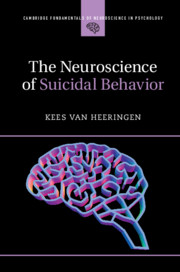Book contents
- Frontmatter
- Dedication
- Contents
- Figures
- Tables
- Preface
- Chapter One What Is Suicidal Behavior, and Can It Be Prevented?
- Chapter Two Stress, Vulnerability, and Suicide
- Chapter Three The Dark Side of the Brain
- Chapter Four Lethal Signals
- Chapter Five I Think, Therefore I Do Not Want to Be
- Chapter Six Images of the Suicidal Brain
- Chapter Seven “In my end is my beginning”
- Chapter Eight I Predict, Therefore I Cannot Be
- Chapter Nine Predicting the Unpredictable
- Chapter Ten The Treatment of Suicide Risk
- Glossary
- References
- Index
- Colour Plates
Chapter Two - Stress, Vulnerability, and Suicide
The Stress–Diathesis Model
Published online by Cambridge University Press: 22 May 2019
- Frontmatter
- Dedication
- Contents
- Figures
- Tables
- Preface
- Chapter One What Is Suicidal Behavior, and Can It Be Prevented?
- Chapter Two Stress, Vulnerability, and Suicide
- Chapter Three The Dark Side of the Brain
- Chapter Four Lethal Signals
- Chapter Five I Think, Therefore I Do Not Want to Be
- Chapter Six Images of the Suicidal Brain
- Chapter Seven “In my end is my beginning”
- Chapter Eight I Predict, Therefore I Cannot Be
- Chapter Nine Predicting the Unpredictable
- Chapter Ten The Treatment of Suicide Risk
- Glossary
- References
- Index
- Colour Plates
Summary
Although there are many pathways to suicide, studies in the domains of neuropsychology, cognitive psychology, neurobiology, and clinical psychiatry provide increasing evidence in support of a stress–diathesis model of suicidal behavior. While depression is the common final pathway to suicidal behavior, the vast majority of depressed individuals neither attempt nor complete suicide. It appears that a diathesis to suicidal behavior differentiates depressed individuals who will kill themselves from other depressed patients. The diathesis may be due to (epi-)genetic effects and childhood adversity, and is reflected by a distinct biological, psychological and clinical profile. This chapter will first review stress-diathesis models of suicidal behavior, ranging from cognitive models such as the “cry of pain” model to a neurobiological model in which deficient decision-making and its neural basis are central issues. Second, implications for treatment and prevention will be discussed. The identification of diathetic traits can be expected to facilitate early recognition of suicide risk. Vulnerability traits are open to modification early in life, and interventions during sensitive periods of development may have durable effects on vulnerability and resilience. The antisuicidal effects of drugs such as lithium and clozapine may well exert such effects via neurobiological components of the diathesis such as the serotonergic neurotransmission system.
Keywords
- Type
- Chapter
- Information
- The Neuroscience of Suicidal Behavior , pp. 23 - 39Publisher: Cambridge University PressPrint publication year: 2018



